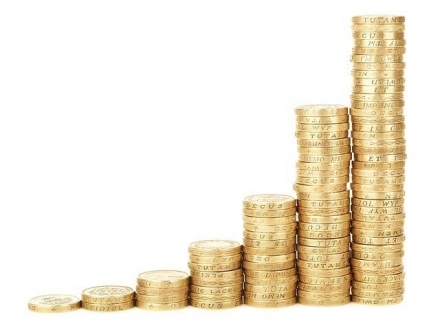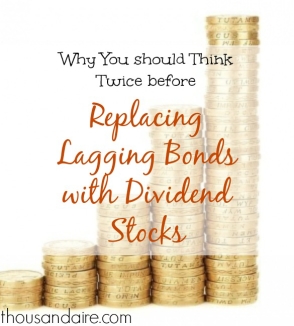Bonds are an important part of any investment strategy. As your time horizon shortens, bonds can be used to reduce the volatility (which should always be read as another word for “risk,” by the way) of your total portfolio. The trade off for this, of course, is that bonds offer lower potential returns than stocks.
Bonds provide interest income, which is taxed at the ordinary income rate, so taxable bonds are best held in a tax-deferred account like an IRA or 401(k) plan.
It’s easier to stomach the lower return of your bond portfolio when yields are high and interest rates are rising, since the absolute numbers are higher. The market disasters of recent memory have increased our tolerance for returns in the 5-7% range, since many of us feel lucky to be getting that much. But when rates are falling and bond yields drop, we sometimes find ourselves getting restless.

The silver lining to a low rate environment?
Enter the seemingly perfect solution – the dividend-paying stock. Like bonds, dividend-paying stocks offer income potential in the form of dividends, usually paid quarterly. However, since they stocks, dividend-payers offer greater return potential than bonds. In fact, dividend-paying stocks tend to outperform non-dividend payers over the long term.
Dividends also have tax advantages over the interest payments offered by bonds. For 2015, the tax rate for dividends is 15% (for all except those earning very high incomes) – the same as the capital gains rate. For this reason, dividend-paying stocks offer greater tax efficiency in a taxable account.
A dangerous strategy
If something looks too good to be true, it probably is, right? In this case, the answer is yes, unfortunately. Replacing taxable bond holdings with dividend-paying stocks may or may not pay off in the short term. But as a long-term strategy, it could end very badly.
A bond is a legal obligation in which the issuer agrees to pay interest in return for the loan. A dividend-paying stock, however, includes no such obligation. Certainly there are stocks that historically, have somewhat reliably paid dividends (that’s why dividend-paying stocks are a category), but there are no guarantees. As with all things performance-related, the past should not be used to predict the future.
Dividend stocks offer higher return potential than bonds, it’s true, but the overall performance numbers don’t tell the whole story. Dividend stocks come with all the volatility of an equity asset class. Swapping out bonds for stocks – any stocks – doesn’t make sense as an overall strategy, since the swap sacrifices the stability the bonds were meant to bring to the portfolio in the first place.
And that higher return potential? It’s not quite that simple. Historically, dividend stocks have outperformed other stocks, it’s true, but in a rising interest rate environment, dividend stocks tend to do poorly as bond yields catch up.
As to the impact of dividends on your tax bill, it should be abundantly clear that the negatives outweigh any potential gains there. Additionally, the tax code can be a fickle thing, and a change in tax law could wipe out this advantage at any point.
Stay the course
None of us likes to feel like we’re missing out, and watching other areas of the market do well can color our view of the less volatile portions of a portfolio. But those allocations are the bedrock that provides a measure of stability to offset stock market swings. Remember that – and let your bond allocations do their job.


I think the safety of bonds is over-rated. They are still promises to pay and that promise is only as good as the person/corporation’s motivation and ability to pay. You can have good high quality bonds that pay next to nothing and bonds with reasonable yields that become quite shaky in a down turn.
You did a good job explaining why dividend aristocrats are so good but I question some of your downsides. I think the crux of your bonds vs. dividends argument rests on your comment, “dividend stocks have outperformed other stocks, it’s true, but in a rising interest rate environment, dividend stocks tend to do poorly as bond yields catch up.” What catch up are you talking about??? If you buy a bond you have a set coupon-rate you will be paid and a set principle repayment. There is absolutely NO CATCH UP involved!! Because of this bonds are much more sensitive to interest rates than almost any other asset. If you buy a bond that pays 2% and rates go up to 4%, you will never get that 4%. That’s simply not what was promised. And if you decide to sell the bond to another party before maturity they will want a sufficient discount in the purchase price to bring their return up to at least the going-rate of 4%. With bonds you are locking in your principal to whatever the interest rate is at the time–PERIOD. This is much like locking in low interest rates on a thirty-year fixed mortgage.
However, with dividend stocks there is SOME indexing to inflation. Yes the monolithic corporations that pay dividends have trouble in a rising interest rate environment. Mostly because of set contracts, large (now high cost) inventories and inertia. But they do have the ability to cycle through these costs and also the ability to pass costs on to their customers. SLOWLY, they index their dividends with inflation—something that bonds can’t do (with the exception of the treasury’s I Bonds).
The best time for bonds to win in a bonds vs. dividends debate is when interests rates are FALLING! In the late 70’s we had incredible inflation and fed chair Volker declared a war on inflation. He kept rising interest rates until it worked. Then slowly (early 80’s) they started the downward trend in interest rates that we are just about ending today. If someone had put large amounts of money in bonds in 1981 they would have been doing great!!! You could get thirty year bonds paying 10% interest. As rates declined you still were getting 10%! If you decided to sell early, you could get premiums on the sale. This is most definitely NOT the environment we are in today. There is nowhere for rates to go but up or sideways.